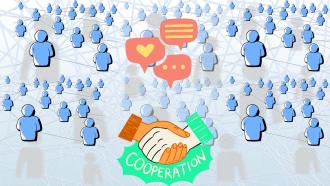
Vaccines are one of humanity’s greatest triumphs. They have eradicated some of the most devastating diseases in history and continue to save millions of lives every year from death and lifelong disability. Smallpox has now been banished to a few high-security biohazard laboratories, and measles might have gone the same way by now if it weren’t for the rise of vaccine denialism in recent years. So, what exactly pushes people to join or remain out of vaccination drives?
Human decision-making is critical to voluntary vaccination programs. In a recent study, published in PLoS Computational Biology, researchers from the Institute of Mathematical Sciences, Chennai, have modelled the outcomes of such programs using game theory. Game theory is a branch of mathematics that studies how agents in an interaction make strategic decisions.
Public memory is short. As a generation, which has never seen the devastation caused by diseases like smallpox, decides whether to vaccinate its children, many factors come into play. It can be very tempting to free-ride on herd-immunity, acquired by a population with a sufficiently high vaccination rate, and avoid the costs of getting the vaccine. The researchers of the current study applied a game-theoretic approach of balancing costs and benefits to a computer model of a voluntary vaccination program.
The model assumed agents, representing people, to be rational and decide their actions based solely on increasing the benefits they would receive or maximising their payoffs. Their decision to vaccinate is based on information about the prevalence of the disease in their neighbourhood. Unlike previous such studies, this model did not assume the population was the same throughout, but varied in terms of the information each agent received and the response the agent made. An agent can be in one of three states—susceptible to the disease, infected by it, or recovered from it. Game theory was then used to model how the agents used available information to decide whether or not to vaccinate at each round.
The benefits of getting vaccinated depend on how many neighbours are infected. If most of them are, the probability of contracting the infection is high. Hence, there is a massive payoff to getting vaccinated and being protected from the disease. Alternatively, the benefits of not getting vaccinated depend on how many neighbours are already protected from the disease. Here, the probability of contracting the disease is low, and the costs of getting vaccines can be avoided with relative safety. As the fractions of the neighbours infected and protected change, the payoffs change and the number of agents choosing to vaccinate changes in response.
The researchers simulated the virtual spread of a disease through social networks of South Indian villages and applied the above model of decision-making. They found that even when vaccine coverage was roughly equal, when the information about disease prevalence was at a global level instead of local, the disease was more widespread. In other words, when agents use global information rather than local information, they choose to vaccinate much later.
The infectiousness of the disease mattered too. While the final number of infected agents was always higher when information was global, an intermediate range of infectiousness was found, wherein the number of vaccinated agents was higher when information was more global than local. This might potentially imply that in the case of global information, a threat doesn’t appear significant until a large proportion of the population is infected, by which time even significant vaccine uptake is insufficient to check the spread of the disease.
One intriguing question that the model does not answer is how rational is ‘rational’? As the authors point out, “failures of vaccination campaigns are often attributed solely to the existence of groups holding anti-vax sentiments or those who are swayed by fake news to take irrational stands on vaccination… Our results may explain why the very success of vaccination campaigns at their initial stages can breed the conditions for their subsequent failure."
The cost of a vaccine might be money, time, effort or potential side-effects, but also the stigma of vaccination in a social group that disapproves of it. Perceived benefits might not necessarily be rational either. Influenza, for example, spreads through a population much more quickly than Ebola, but creates much less of a public scare simply because it is perceived as less threatening. If the goal of a vaccination program is to increase vaccination rates, the researchers suggest that accurate information about the spread of disease at a local level is crucial to influence the way people perceive the risks and benefits of vaccination. Seeing is believing for many aspects of human behaviour; vaccination programs would do well to remember that.
This article has been run past the researchers, whose work is covered, to ensure accuracy.






